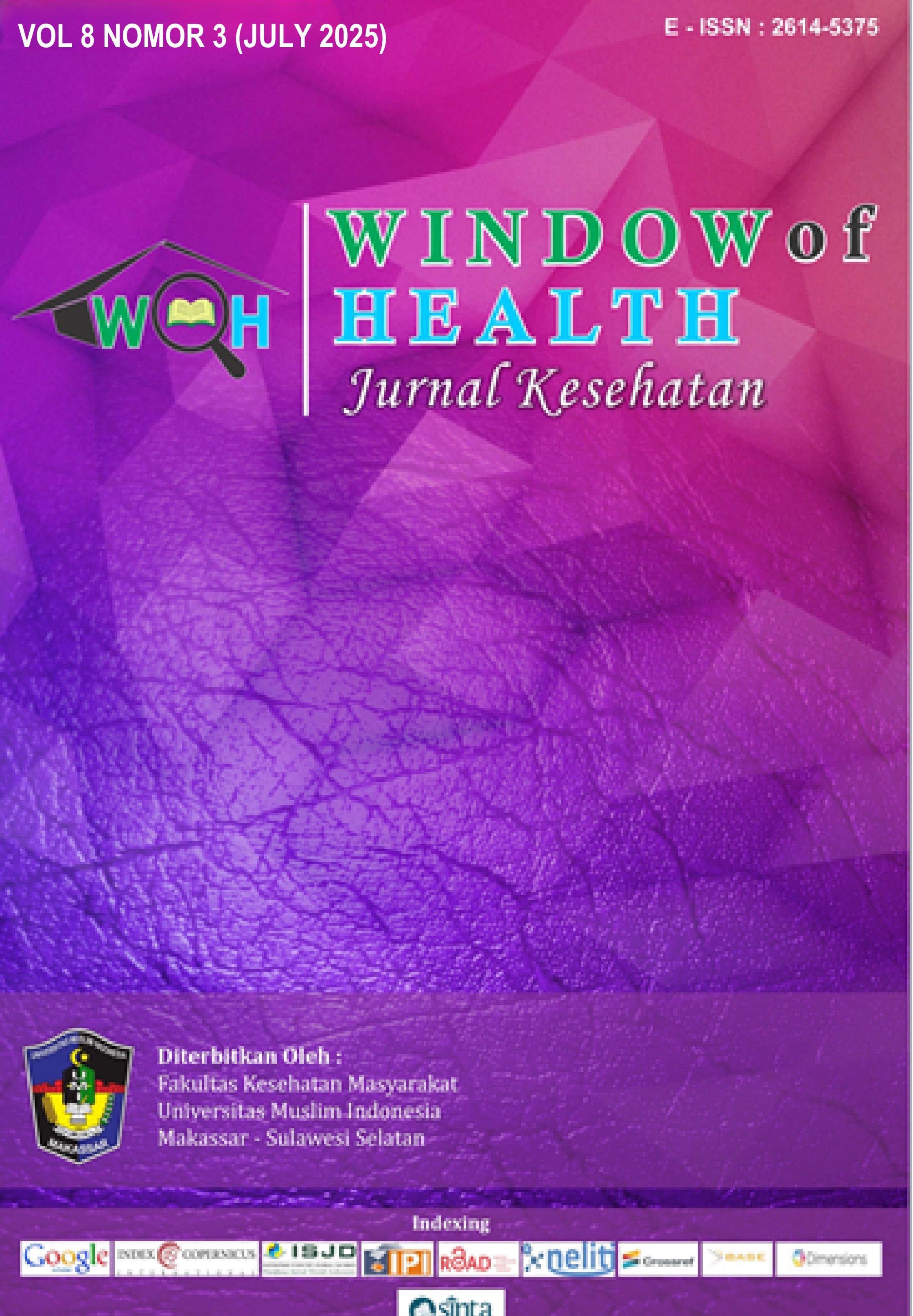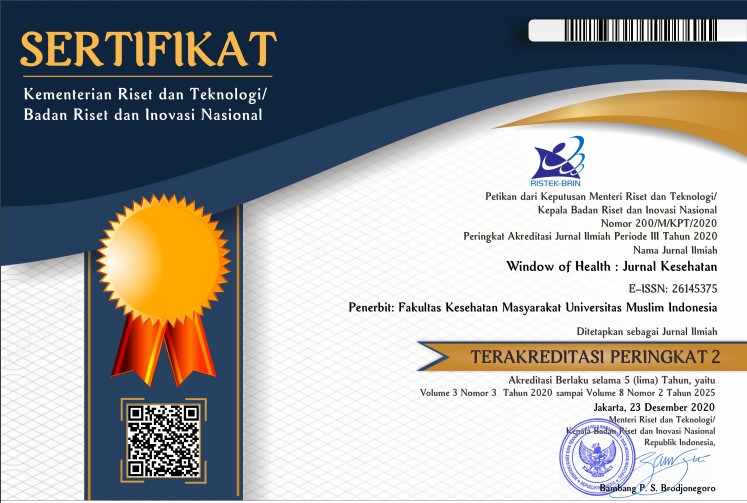Models of the Effects of Ultraviolet Exposure, Temperature, and Humidity on the Quantity of Microplastics in Indoor Air
Abstract
Microplastics are a new pollutant in the air, but the determination of the maximum limit of their existence has not been set in regulations. Microplastics found in the air of building spaces are made from plastic waste. The presence of microplastics in the air is influenced by physical environmental factors. Inhaling microplastics can have a detrimental impact on lung tissue. The research aims to create a mathematical model of the effect of ultraviolet exposure, temperature, and humidity on the quantity of microplastics in indoor air. Mathematical models can be used to predict the quantity of microplastics in the air. The type of research is a true experiment with a posttest-only control group design. Air samples are taken daily for 60 days by the passive method by taking dustfall. The parameters measured include the quantity of microplastics, ultraviolet intensity, temperature, and air humidity. Microplastic examination by visual method using a 40-fold magnification binocular microscope. Analysis of the mathematical model of the effect of ultraviolet exposure, temperature, and humidity on the quantity of microplastics in the form of time series data using linear regression. The results of data analysis show that the effect of the panel regression estimation model, in accordance with the empirical data, is the Fixed Effect Model (FEM). The conclusion based on the results of the study shows that physical environmental factors have an influence on the quantity of microplastics in the air, whose existence can be predicted using FEM modeling that has been made.
References
Pollution MP, Safety S. New Link in the Food Chain? : Marine PLastic and Seafood Saftey. 2015;123(2):34–42.
Kementerian Lingkungan Hidup RI. Komposisi Sampah [Internet]. 2022 [cited 2023 Aug 18]. Available from: https://sipsn.menlhk.go.id/sipsn/public/data/komposisi
GESAMP. Guidelines or the monitoring and assessment of plastic litter in the ocean. 2019.
Lusher A, Hollman P, Mandoza-Hill J. Microplastics in fisheries and aquaculture [Internet]. Vol. 615, FAO Fisheries and Aquaculture Technical Paper. 2017. 127 p. Available from: http://www.fao.org/3/a-i7677e.pdf
Widianarko B, Hantoro I. Mikroplastik Mikroplastik dalam Seafood Seafood dari Pantai Utara Jawa. Unika Soegijapranata. Semarang. 2018. 86 halaman.
Karbalaei S, Hanachi P, Walker TR, Cole M. Occurrence, sources, human health impacts and mitigation of microplastic pollution. Environmental Science and Pollution Research [Internet]. 2018 Dec 31;25(36):36046–63. Available from: http://link.springer.com/10.1007/s11356-018-3508-7
WHO. Microplastics in Drinking Water. Switzerland: World Health Organization; 2019.
Dris R, Gasperi J, Mirande C, Mandin C, Guerrouache M, Langlois V, et al. A first overview of textile fibers, including microplastics, in indoor and outdoor environments. Environmental Pollution. 2017;221:453–8.
Soltani NS, Taylor MP, Wilson SP. Quantification and exposure assessment of microplastics in Australian indoor house dust. Environmental Pollution. 2021;283.
Bahrina I. Korelasi Aktivitas Karyawan dan Mikrplastik di Udara (Studi Kasus: Dalam Sebuah Gedung Perkantoran Pemerintah di Surabaya) [Internet]. Institut Teknologi Sepuluh November; 2021. Available from: https://respository.its.ac.id/83450/
Xie Y, Li Y, Feng Y, Cheng W, Wang Y. Inhalable microplastics prevails in air: Exploring the size detection limit. Environ Int [Internet]. 2022;162:107151. Available from: https://doi.org/10.1016/j.envint.2022.107151
Luis Fernando Amato-Lourenco, Regiani Carvalho-Oliveira, Gabriel Ribeiro, Juniora Lucianados Santos Galvao, Romulo Augusto Ando TM. Presence of airborne microplastics in human lung tissue. J Hazard Mater [Internet]. 2021;416(Agustus):126124. Available from: https://www.sciencedirect.com/science/article/pii/S0304389421010888?casa_token=LgtdRYGs2jIAAAAA:Jx-iOZoG3BTMTlMRkG5BQ6qcsG9GK-0cLSr60NqZvO6lENeTaZifQGCCyYKg3Yu78x3RdDra
Acharya S, Rumi SS, Hu Y, Abidi N. Microfibers from synthetic textiles as a major source of microplastics in the environment: A review. Textile Research Journal [Internet]. 2021 Sep 4;91(17–18):2136–56. Available from: https://journals.sagepub.com/doi/10.1177/0040517521991244
Kacprzak S, Tijing LD. Microplastics in indoor environment: Sources, mitigation and fate. J Environ Chem Eng [Internet]. 2022 Apr;10(2):107359. Available from: https://linkinghub.elsevier.com/retrieve/pii/S2213343722002329
Liu K, Wang X, Wei N, Song Z, Li D. Accurate quantification and transport estimation of suspended atmospheric microplastics in megacities: Implications for human health. Environ Int [Internet]. 2019;132(September):105127. Available from: https://doi.org/10.1016/j.envint.2019.105127
Prata JC, Castro JL, da Costa JP, Duarte AC, Rocha-Santos T, Cerqueira M. The importance of contamination control in airborne fibers and microplastic sampling: Experiences from indoor and outdoor air sampling in Aveiro, Portugal. Mar Pollut Bull [Internet]. 2020 Oct;159:111522. Available from: https://linkinghub.elsevier.com/retrieve/pii/S0025326X20306408
Liao Z, Ji X, Ma Y, Lv B, Huang W, Zhu X, et al. Airborne microplastics in indoor and outdoor environments of a coastal city in Eastern China. Vol. 417, Journal of Hazardous Materials. 2021.
Mulyasari TM, Mukono J, Sincihu Y. The presence of microplastics in the Indonesian environment and its effects on health. J Public Health Afr. 2023;14(S2).
Sa A, Trihadiningrum Y. Kajian Fragmentasi Low Density Polyethylene Akibat Radiasi Sinar Ultraviolet dan Kecepatan. 2020;9(2).
Dong C Di, Chen CW, Chen YC, Chen HH, Lee JS, Lin CH. Polystyrene microplastic particles: In vitro pulmonary toxicity assessment. Vol. 385, Journal of Hazardous Materials. 2020.
Chen G, Feng Q, Wang J. Mini-review of microplastics in the atmosphere and their risks to humans. Science of the Total Environment [Internet]. 2020;703:135504. Available from: https://doi.org/10.1016/j.scitotenv.2019.135504
Gasperi J, Wright SL, Dris R, Collard F, Guerrouache M, Langlois V, et al. Microplastics in air : Are we breathing it in ? To cite this version : HAL Id : hal-01665768 Microplastics in air : are we breathing in it ? Current Opinion in Environmental Science &H Health. 2018;1:1–5.
Sulistomo HW, Janasti L, Trinovita R, Ratnaningrum SD, Kusuma ID. The Effect of Sub-Acute Inhalation Exposure to Polyethylene and Polyvinyl Chloride Micro-Nano Plastics on the Superoxide Dismutase (SOD) Level and Malondialdehyde (MDA) Level in Rat Ovary. 2024;22:494–501.
Faisal Hayat M, Ur Rahman A, Tahir A, Batool M, Ahmed Z, Atique U. Palliative potential of robinetin to avert polystyrene microplastics instigated pulmonary toxicity in rats. J King Saud Univ Sci [Internet]. 2024;36(9):103348. Available from: https://doi.org/10.1016/j.jksus.2024.103348
Tomonaga T, Higashi H, Izumi H, Nishida C, Kawai N, Sato K, et al. Investigation of pulmonary inflammatory responses following intratracheal instillation of and inhalation exposure to polypropylene microplastics. Part Fibre Toxicol [Internet]. 2024;21(1). Available from: https://doi.org/10.1186/s12989-024-00592-8
Campanale C, Massarelli C, Savino I, Locaputo V, Uricchio VF. A detailed review study on potential effects of microplastics and additives of concern on human health. Int J Environ Res Public Health. 2020;17(4).
Copyright (c) 2025 Tri Marthy Mulyasari, Nur Hilal, Teguh Widiyanto, Lagiono

This work is licensed under a Creative Commons Attribution-NonCommercial-ShareAlike 4.0 International License.








